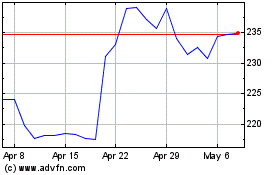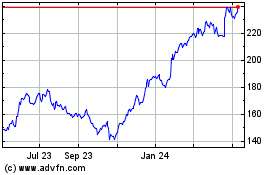By AnnaMaria Andriotis and Peter Rudegeair
American Express Co. is pushing into the booming personal-loan
business despite investor worries that an expanding roster of
lenders may be getting into the game at too late a stage.
Such fears put AmEx executives on the defensive Wednesday at
their annual investor day conference. Chief Executive Ken Chenault
acknowledged the company has received questions about the timing of
recent efforts to expand lending. These include through credit
cards and expanding last year into personal loans -- the first time
the iconic card company has engaged in such lending.
But he said that AmEx is "very comfortable" because the
initiative involves lending more to its existing card
customers.
AmEx's foray into personal loans is happening as the company is
under pressure to maintain market share in the card market while
also fending off growing competition from a host of lending rivals.
Its fourth-quarter earnings were lackluster and the company has had
to ramp up marketing and promotion expenses, although the company's
stock has outperformed rivals Visa Inc. and Mastercard Inc. over
the past year.
Others who also have recently made a move into personal loans
include Goldman Sachs Group Inc., which last fall began offering
them through its new consumer-focused business, Marcus. British
bank Barclays PLC has also joined in and began late last year to
offer personal loans by invitation to select U.S. Barclaycard and
potential new customers.
Discover Financial Services, too, is ramping up in personal
loans. The card issuer originated $4 billion of such loans in 2016,
up 31% from the year prior and the highest ever for the
company.
In 2016, lenders overall originated some $133 billion of
personal loans in the U.S. -- the most in at least 10 years and
nearly double the volume in 2010, according to Experian.
So far, business has been good, with an improving U.S. economy
keeping defaults and delinquencies low. But some analysts warn that
firms entering the market now are taking on more risk, because late
payments tend to rise as the economy enters the late stages of a
long-running expansion. The U.S. recovery is now entering its ninth
year.
"It's probably in the sixth or seventh inning," said Jason
Arnold, an analyst at RBC Capital Markets.
Yet many firms fear they will miss out on easy profits if they
don't make personal loans, allowing rival lenders and upstarts
alike to lure away their best customers. That could punish results
at a time when growth has been at a premium.
"You have a choice -- you either better serve the needs of the
customers or run the risk that they leave you," said Todd Nelson,
business development officer at SunTrust Banks Inc.'s LightStream,
an online-lending unit that originates personal loans.
In the wake of the financial crisis, many banks cut back on
these loans, due to losses suffered during the meltdown, tightened
standards and reduced risk-taking. This left an opening for online
lenders such as LendingClub Corp. and Prosper Marketplace Inc.
Online lenders have been using these loans to appeal to mostly
creditworthy consumers who want to consolidate high-interest
credit-card debt. Around three out of every five loans LendingClub
has made since it began lending in 2007, for instance, went toward
paying off higher-cost debt, according to data from the San
Francisco-based company.
While personal loan rates often range from 6% to 20%,
credit-card charges often exceed 20%. The lenders, meanwhile have
been borrowing at rates that allowed them to generate healthy
returns.
And there are plenty of credit-card customers to target. Total
credit-card balances have grown to be just shy of $1 trillion,
climbing steadily toward crisis-era levels. The Federal Reserve
reported this week that balances in January were $995 billion.
For Goldman, entering the personal-loan market was easy. The
Wall Street giant, which has long catered to institutional
customers and wealthy individuals, didn't have existing consumer
balances that could be put at risk.
Because the firm doesn't have a credit-card portfolio, "the
decision didn't involve disintermediating ourselves," said Stephen
Scherr, Goldman's chief strategy officer and chief executive of GS
Bank USA. "We weren't burdened by any other business or other
legacy platform."
The same can't be said for AmEx or other card companies. As a
result, AmEx's loan offers are currently only made to existing card
customers and come with a catch: Borrowers can't use an AmEx
personal loan to refinance an AmEx card balance.
"We are focused on addressing the borrowing needs of our
premium, high-credit quality card member base with whom we have a
long history," said Kartik Mani, AmEx executive vice president of
global consumer lending.
And at AmEx's investor day presentation, Doug Buckminster,
president of the company's global consumer-services group, stressed
the credit quality of AmEx borrowers. He added that the company's
overall consumer-loan portfolio -- which consists mostly of
credit-card holders who carry balances -- has significantly lower
exposure to borrowers with low FICO scores than it did in 2007.
While consumers took on more credit-card debt last year, AmEx
was the only one of the 10 largest card issuers to post a
year-over-year decline in U.S. general-purpose card balances,
according to The Nilson Report. They fell 6% in 2016 from a year
earlier, due largely to the loss of card partnerships with Costco
Wholesale Corp. and JetBlue Airways Corp., Nilson Report data
show.
Write to AnnaMaria Andriotis at annamaria.andriotis@wsj.com and
Peter Rudegeair at Peter.Rudegeair@wsj.com
(END) Dow Jones Newswires
March 09, 2017 13:48 ET (18:48 GMT)
Copyright (c) 2017 Dow Jones & Company, Inc.
American Express (NYSE:AXP)
Historical Stock Chart
From Mar 2024 to Apr 2024

American Express (NYSE:AXP)
Historical Stock Chart
From Apr 2023 to Apr 2024
